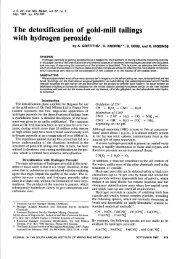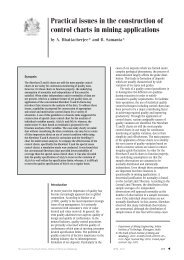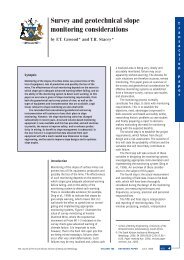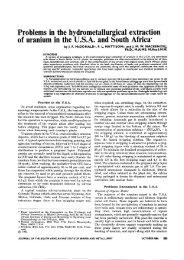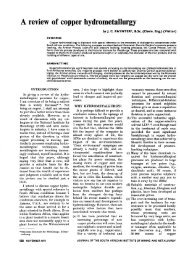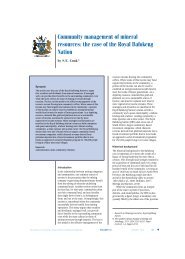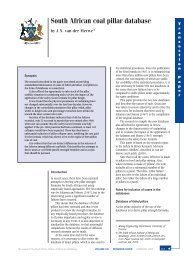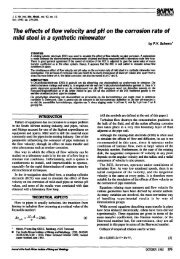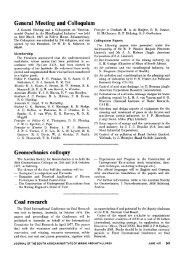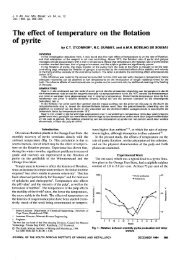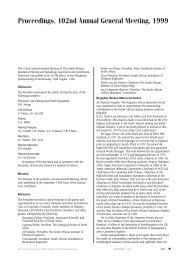changes. On the other hand, above about 25 °0 there is no significant increase in the rate <strong>of</strong> <strong>gold</strong> dissolution with temperature. <strong>The</strong> chemical behaviour <strong>of</strong> the <strong>gold</strong> in <strong>concentrates</strong> during leaching is similar to that <strong>of</strong> pure <strong>gold</strong>, and all the reactions that apply to pure <strong>gold</strong> appear to be valid for the <strong>gold</strong> present in <strong>concentrates</strong>. Numerous investigators have revealed that the dissolution <strong>of</strong> pure <strong>gold</strong> is usually controlled by diffusion. At low temperatures the rate control <strong>of</strong> <strong>gold</strong> dissolution can change from diffusion to reaction rate control. This change-over can be aptly demonstrated from the data <strong>of</strong> Julian and Smart. If the data illustrated in Fig. 7 are plotted in the form <strong>of</strong> log (rate) against the reciprocal <strong>of</strong> absolute temperature, a curve similar in shape to that presented in Fig. 7 is obtained. However, the portions below about 15°0 and from 25 to 70°0 yield straight lines with different slopes. From these respective slopes, an activation energy <strong>of</strong> about 13 kcalfmol can be derived from the line through the low temperature points, and approximately 2 kcalfmol for the temperature range 25 to 70°0. For the type <strong>of</strong> heterogeneous reaction in the liquid phase that TABLE EFFECT OF MILL RETURN WATER ON GOLD DISSOLUTION FROM BELT CONCENTRATES AT VARIOUS TEMPERATURES USING A FLOTATION- MACHINE TYPE OF AGITATOR Type <strong>of</strong> water Temperature (OC) Au (g/t) Residue Ag (g/t) IX Extraction Au Ag (%) (%) Residual (NaCN) (g/l) Deionizoo Deionized Deionized Deionized Deionized Deionizoo Mill Return Mill Retum Mill Return Mill Return Mill Return Mill Retum Material: Conditions: 15 446 20 170 25 128 35 81,4 45 79,2 55 1l0 15 640 20 128 25 82,9 35 104 45 114 55 99,0 Sample W4 (19,4 kg/t Au) Liquid: solid ratio 2: I NaCN addition 40 kg/t Oxygen flow-rate 200 cm3/min Reaction time 2 h 54,4 31,6 21,0 23,0 21,2 24,5 65,0 23,8 14,7 28,3 14,0 30,0 97,6 98,9 99,1 99,4 99,3 99,6 99,6 99,5 99,6 99,6 99,4 99,5 96,6 98,7 99,3 99,5 99,7 99,7 99,4 99,4 99,4 99,7 99,5 99,4 8,5 7,8 8,1 7,7 8,0 7,8 8,2 7,9 7,9 8,4 8,1 8,2 160 w ~ 150 .... .... ~ 140 ~ w A. 0 130 w ~ 0 ~ 120 0 0 110 C) L"- 0 .... 100 J: C) w ~ 90 0 20 40 60 80 100 TEMPERATURE (OC) Fig. 7-Effect <strong>of</strong> temperature on the dissolution <strong>of</strong> pure <strong>gold</strong> (after Julian and Smart") JOURNAL OF THE SOUTH AFRICAN INSTITUTE OF MINING AND METALLURGY JANUARY 1978 159
IS responsIble for <strong>gold</strong>. dissolution, the hIgher actIvatIon energy is characteristic for a reaction rate controlled process, while the lower one is typical for diffusion controlled svstems. Evidence for a change from reaction rate controi at low temperature to diffusion control at the higher temperature was also found in the present investigation, i.e., below 20°C the <strong>gold</strong> dissolution rate had a strong dependence on temperature, whilst above about 20°C no change <strong>of</strong> <strong>gold</strong> dissolution rates with increase in temperature could be determined. Further evidence regarding diffusion control above 20 °C was that, under normal operating conditions, increased agitation and aeration and an increase in oxygen partial pressure resulted in increases in the <strong>gold</strong> dissolution rates. Other Reaction Variables It became most apparent during the course <strong>of</strong> the present investigation that the reaction variables including pH, cyanide concentration, and time had very complex compounding effects upon one another, and as such were difficult to define. As the definition <strong>of</strong> these compounding effects necessitated' a large number <strong>of</strong> tests, further study was confined to simple tests involving the rolling <strong>of</strong> bottles. Some 500 to 600 individual tests were conducted (the equipment being housed in a thermostatically controlled cabinet). For the sake <strong>of</strong> brevity, only the more pertinent features <strong>of</strong> this st,udy are discussed here. <strong>The</strong> effect <strong>of</strong> reaction time on the extraction <strong>of</strong> <strong>gold</strong> from various <strong>concentrates</strong> in the presence <strong>of</strong> air is shown in Fig. 8. It can be seen that, after an initial acceleration 100 90 80 70 * Z 0 60 U 0- : 50 0- X W 0 -' 40 0 C> 30 0 0 5 10 CONTACT TIME (h) Fig. B-Effect <strong>of</strong> contact time on the dissolution <strong>of</strong> <strong>gold</strong> from belt concentrate at 20°C 0 Sample WI (Au 6,3 kilt) A Sample W3 (Au 12,2 kilt) . SampleW2(Au22kilt) . SampleW4 (Au 19,4kilt) 15 perIod, the rate <strong>of</strong> <strong>gold</strong> dissolution is almost constant for a considerable time (1 to 4 hours), and that this rate is roughly proportional to the original <strong>gold</strong> concentration, i.e., the higher the head grade, the faster the dissolution. In other words, the percentage extraction with time is roughly the same even for <strong>concentrates</strong> with very different <strong>gold</strong> contents. This cannot be strictly true for reasons that will be given later. As expected, these reaction rates, which would yield a <strong>gold</strong> dissolution <strong>of</strong> 100 per cent in 4 to 5 hours irrespective <strong>of</strong> the head value, do not continue. After about 70 to 80 per cent <strong>of</strong> the <strong>gold</strong> has been dissolved, the rate <strong>of</strong> dissolution decreases significantly and becomes very slow after about 7 hours, when about 95 per cent <strong>of</strong> the <strong>gold</strong> has been dissolved. Approximately the same time is required for the dissolution <strong>of</strong> most <strong>of</strong> the remaining 5 per cent as for the dissolution <strong>of</strong> the first 95 per cent. Under similar experimental conditions but for extended leaching times (48 to 96 hours), the final residual <strong>gold</strong> values were approximately 10 to 20 gjt for all the <strong>concentrates</strong> so far investigated (Wl to W4). <strong>The</strong>se residual <strong>gold</strong> values appear to be independent, within reasonable limits, <strong>of</strong> the magnitude <strong>of</strong> the reaction variables; that is, under all reasonable operating conditions, a final residual <strong>gold</strong> value, which is characteristic <strong>of</strong> the particular concentrate, can be achieved if leaching is continued for a long enough time. It also means that, at extended leaching times, all the confounding effects disappear. Thus, the effectiveness <strong>of</strong> any variation in the operating conditions can be assessed by the leaching time required to reach residual <strong>gold</strong> values <strong>of</strong> 10 to 20 gjt in the present instance or by how closely this residual value can be approached in a given time. Generally, the dissolution <strong>of</strong> silver followed the same trend as that <strong>of</strong> <strong>gold</strong>, but the dissolution <strong>of</strong> silver appeared to be somewhat slower than the dissolution <strong>of</strong> <strong>gold</strong> and, during the progress <strong>of</strong> the reaction, the <strong>gold</strong>: silver residue ratio decreased from its original value <strong>of</strong> about 9:1 to roughly 5:1. <strong>The</strong> leaching <strong>of</strong> sized fractions was undertaken for two reasons. First, it was suspected that the coarser <strong>gold</strong> might be responsible for the slower leaching rates observed after about 70 to 80 per cent <strong>of</strong> the <strong>gold</strong> had been dissolved. Second, it was hoped that this exercise might throw more light on the nature <strong>of</strong> the refractory or residual <strong>gold</strong>. In the past, speculations about the nature <strong>of</strong> this <strong>gold</strong> had ranged from its being occluded <strong>gold</strong> to its being <strong>gold</strong> in solid solution or even adsorbed <strong>gold</strong>. <strong>The</strong> observation that milling in cyanide or milling followed by <strong>cyanidation</strong> lowered the residual value considerably hinted strongly at occluded <strong>gold</strong>. Occluded <strong>gold</strong> particles were also observed during microprobe analyses <strong>of</strong> the leach rcsidues. A size analysis and <strong>gold</strong> distribution <strong>of</strong> the fractions used in the present investigation are presented in Table II, and the results <strong>of</strong> leaching tests are shown in Fig. 9. As expected, the +147 IA-msize fraction, which contained the lowest concentration <strong>of</strong> <strong>gold</strong>, had the slowest leaching rate, whilst the -74 IA-mfraction leached the fastest. In spite <strong>of</strong> the large difference in the head grade <strong>of</strong> <strong>gold</strong> between the coarsest and the finest fractions, the actual residual <strong>gold</strong> value after about 3 hours leaching 160 JANUARY 1978 JOURNAL OF THE SOUTH AFRICAN INSTITUTE OF MINING AND METALLURGY




